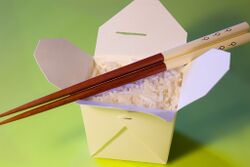Engineering:Oyster pail

An oyster pail (also known as a paper pail, Chinese food box or Chinese takeout container) is a folded, waxed or plastic coated, paperboard container originally designed to hold oysters. It commonly comes with a handle made of solid wire. Currently, it is often in use by American Chinese cuisine restaurants primarily throughout the United States, to package hot or cold take-out food. It can also sometimes be found in other Western countries, such as Australia, New Zealand, Germany, Poland, England and Brazil, but is rarely seen in China and other Asian countries with high numbers of ethnic Chinese.
Uses
The container has the advantage of being inexpensive, durable and fairly leak-proof when kept upright. The top usually includes a locking paperboard tab so that it is self-closing. The simple origami-like folded construction allows for some escape of steam from hot food. It is typical to eat directly out of the container with chopsticks. The containers are primarily used with American Chinese cuisine, though they have begun to spread in some European and Latin American countries.
Oyster pails that can be used safely in microwave ovens (without the metal handle, which can cause arcing) are available. Microwave-safe pails often have no handle, or a plastic handle. If an oyster pail has no visible handle, care must be taken to ensure there are no metal clamps before microwaving.
The containers may also be used for storing or transporting non-food items, such as soap bath beads or small parts. Takeout containers have also been offered as novelty packaging for small gifts.[1]
History
Early patents date to 1890,[2] 1894,[3] and 1908.[4] The paperboard oyster pail was invented at a time when fresh oysters were more popular, more plentiful, and less expensive than they are today. Since shucking oysters (removing the raw meat from the shell) takes some skill and can be difficult and dangerous, it was common to have the oyster seller open the oysters so they could be taken home for use in recipes[citation needed]. The oyster pail provided an inexpensive and sanitary way to do this. In the early 20th century oyster pails were used to hold honey.[5] In the mid-20th century, overfishing (and the subsequent rise in price) of oysters left manufacturers with a significant number of unsold oyster pails.

In the US after World War II, there was a huge increase in sales of takeout foods that could be purchased from restaurants, and heated at home. Chinese food proved to be a popular choice, since it was tasty, unusual, fairly inexpensive and traveled well. The oyster pail was quickly adopted for "Chinese takeout". The paperboard pails were to some extent self-insulating, and could be used for a wide variety of foods including cooked rice, moist dishes such as egg foo young and sauced dishes, though they were generally unsuitable for hot highly liquid dishes such as soups.
The containers are also used by restaurants offering classic American takeout food, such as French fries or fried clams, but the containers have become strongly associated with Chinese takeout. In 2011, the Smithsonian National Museum of American History displayed Chinese takeout containers in its exhibit Sweet & Sour: A Look at the History of Chinese Food in the United States.[6]
See also
Notes
- ↑ Hofmann, Deborah (December 14, 1988). "New Gift Wraps: Gloss, Glitter and Ease". New York Times. https://www.nytimes.com/1988/12/14/garden/new-gift-wraps-gloss-glitter-and-ease.html.
- ↑ Wilcox, F W & W D Moshier, "Paper pail", US patent 426698, published 19 Apr 1890
- ↑ "Paper pail". https://patents.google.com/patent/US529053A/en.
- ↑ Reber, J G, "Oyster pail", US patent 886074, published 28 April 1908
- ↑ Root, Amos Ives (1905). The ABC of bee culture: a cyclopaedia of every thing pertaining to the care ... - Amos Ives Root. https://books.google.com/books?id=_p5lAAAAMAAJ&dq=%22oyster+pail%22&pg=PA75. Retrieved 2012-12-12.
- ↑ "Sweet & Sour: A Look at the History of Chinese Food in the United States". Smithsonian Asian Pacific American Center. Smithsonian National Museum of American History. http://apanews.si.edu/2011/03/04/sweet-and-sour-showcase/.
 |
